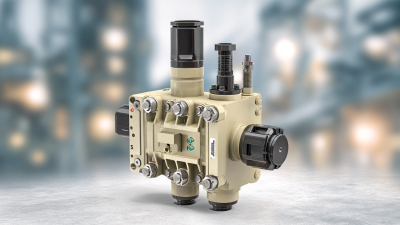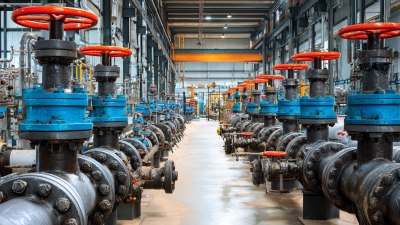In the ever-evolving landscape of manufacturing and processing industries, sanitary valves play a crucial role in maintaining product integrity and ensuring safety in fluid handling applications. According to a recent report by MarketsandMarkets, the global sanitary valves market is projected to reach USD 9.23 billion by 2025, growing at a CAGR of 5.8% from 2020 to 2025. However, despite their importance, these specialized valves face various challenges that can compromise their performance and reliability. Common issues such as leakage, contamination, and difficulty in maintenance not only affect operational efficiency but also pose risks to product quality. Understanding these challenges is essential for industries that prioritize hygiene and safety, making it imperative to explore effective solutions to enhance the functionality and longevity of sanitary valves.

Sanitary valves are critical components in various industries, particularly in food, beverage, and pharmaceuticals, where maintaining sterility and product integrity is paramount. However, these valves can face several common failures that impact operational efficiency and product safety. According to a report by the International Society for Pharmaceutical Engineering, approximately 30% of system failures can be traced back to valve malfunctions, underscoring the importance of understanding the common issues associated with these devices.

One prevalent type of failure is seat leakage, often caused by wear and tear or improper installation. A study published in the Journal of Food Engineering indicates that improper sealing techniques can lead to significant product contamination, affecting up to 25% of batches produced. Moreover, mechanical failures such as actuator breakdowns can obstruct operations, resulting in costly downtime. It is estimated that unplanned downtime due to valve issues can cost businesses up to $10,000 per hour, emphasizing the need for regular maintenance and monitoring to mitigate these risks. By implementing proper installation practices and routine inspections, industries can enhance the reliability of sanitary valves and ensure compliance with stringent health regulations.
Sanitary valves play a crucial role in various industries, especially in food and pharmaceutical sectors, where maintaining hygiene is paramount. Recognizing the symptoms of malfunctioning sanitary valves is essential for ensuring operational efficiency and product quality. Common issues might include leaks, unusual noises, or inconsistent pressure readings. These symptoms could indicate internal wear, improper installation, or even the presence of contaminants.
**Tips:** To address these issues effectively, regular inspections and routine maintenance are vital. Always check for visible signs of wear and tear, and consider implementing a predictive maintenance schedule based on usage patterns. Utilizing advanced diagnostic tools can also help identify potential problems before they escalate, ensuring a smooth operation.
In addition, staying informed about emerging technologies in valve monitoring, such as AI-driven diagnostics, can enhance your ability to detect faults early. By incorporating machine learning and other smart solutions, businesses can analyze valve performance data more comprehensively, allowing for timely interventions that prevent major failures.
Sanitary valves play a crucial role in maintaining the hygiene and integrity of processes in industries such as food and beverage, pharmaceuticals, and biotechnology. However, these critical components are not without their challenges. Regular maintenance is key to ensuring optimal performance and longevity. Research indicates that improper maintenance can lead to a 20-30% reduction in valve efficiency, impacting production and increasing operational costs.
To mitigate common issues such as leakage or contamination, adopting effective maintenance strategies is essential. Regular inspection and cleaning schedules should be established, focusing on areas prone to build-up or wear. For instance, it’s advisable to replace gaskets and seals every six months to prevent leaks, as they are often the first point of failure.
Tip: Always use manufacturer-recommended cleaning agents to avoid damaging valve materials.
Moreover, keeping detailed records of maintenance activities helps identify patterns and potential problems. Implementing predictive maintenance techniques can lead to a decrease in unplanned downtime by up to 50%, allowing for timely interventions before issues escalate.
Tip: Utilize condition-monitoring tools to track valve performance and receive alerts for any deviations from normal operating conditions.

When selecting sanitary valves, it is crucial to prioritize designs that minimize the risk of common issues such as leaks and contamination. According to the 2022 International Journal of Sanitary Engineering Research, improper valve selection can lead to a 25% increase in maintenance costs due to frequent repairs and replacements. To mitigate these risks, it's essential to consider the materials used in valve construction. For instance, stainless steel grades like 316L are often recommended due to their excellent corrosion resistance and cleanliness, which are vital in maintaining hygiene standards in food and pharmaceutical industries.
Additionally, understanding the specific application requirements can significantly impact the longevity and functionality of sanitary valves. A report by the Fluid Control Institute indicates that over 30% of valve failures stem from mismatched pressure ratings and sizes. By conducting thorough risk assessments and consulting manufacturer specifications, operators can select valves that not only meet their operational demands but also adhere to compliance regulations, ultimately enhancing system efficiency and reducing the likelihood of unexpected downtimes.
| Challenge | Common Issues | Possible Solutions | Best Practices for Selection |
|---|---|---|---|
| Corrosion | Degradation of valve materials due to chemical exposure. | Choose corrosion-resistant materials like stainless steel or special alloys. | Evaluate chemical compatibility during the selection process. |
| Leakage | Fluid leakage around the valve seat or stem. | Regular maintenance and replacement of seals and gaskets. | Select valves with reliable sealing technology and materials. |
| Blockages | Solid particles may accumulate and disrupt flow. | Implement routine cleaning and inspection protocols. | Opt for designs that minimize dead zones and allow for easy operation. |
| Temperature Variability | Impact on valve performance and material integrity. | Use valves rated for varying temperature ranges. | Investigate thermal insulation solutions or temperature monitoring systems. |
| Pressure Drops | Increased resistance causing inefficiencies. | Utilize proper sizing and maintain consistent flow rates. | Select valves with optimal flow characteristics for the application. |
In the food and beverage industry, sanitary valves play a crucial role in ensuring the safety and integrity of products. However, common challenges such as contamination, leakage, and maintenance issues can hinder operational efficiency. According to a report by the International Society of Automation (ISA), over 30% of valve failures are attributed to improper installation and maintenance, leading to significant downtime and financial losses for manufacturers. To tackle these challenges, industries are increasingly turning to innovative solutions that streamline operations and enhance valve reliability.
One effective approach is the integration of smart technology into sanitary valve systems. Advanced sensors can provide real-time monitoring of valve performance, enabling early detection of issues such as wear and tear. A study published in the Journal of Food Engineering indicates that facilities utilizing predictive maintenance strategies can reduce maintenance costs by up to 25% and increase overall equipment effectiveness by 15%. Additionally, the adoption of high-quality materials, such as FDA-approved polymers and stainless steel, is critical for minimizing contamination risks. By implementing these innovative solutions, manufacturers can not only address the common challenges associated with sanitary valves but also ensure compliance with health and safety regulations, ultimately leading to improved product quality and customer satisfaction.





